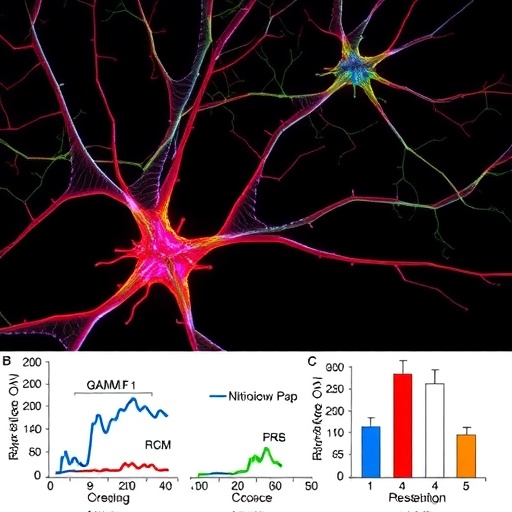In a ground-breaking study published in BMC Neuroscience, researchers led by S.C. Roy and his colleagues have revealed the intricate role played by neuronal nitric oxide (NO) in the ventromedial hypothalamic nucleus (VMH) and its impact on GABAergic neurons within the male rat’s brain. This research not only deepens our understanding of the metabolic mechanisms governing neuronal function but also introduces potential therapeutic avenues for addressing metabolic disorders.
The ventromedial hypothalamic nucleus has long been recognized as a central hub for the regulation of energy homeostasis and body weight. While previous studies have indicated its importance in neuroendocrine functions, the precise molecular signaling pathways have remained elusive. This new research sheds light on the interactions between NO and GABAergic neurons, a connection that could be key to deciphering how metabolic signals influence neuronal activity and overall energy balance.
Nitric oxide, a free radical gas, acts as a crucial signaling molecule in the nervous system, influencing various physiological processes including neuronal excitability and neurotransmitter release. However, its role in the specific context of GABAergic neurons in the VMH provides a novel perspective on how metabolic signals can directly influence these inhibitory pathways. By employing targeted genetic knockdown of neuronal nitric oxide synthase (nNOS), the research team was able to observe significant changes in the expression of genes associated with GABAergic signaling.
The results of this investigation were surprising and profound. The knockdown of nNOS within the VMH led to altered expression levels of several marker genes that are crucial for GABAergic neurotransmission. Notably, genes involved in both the synthesis and release of GABA were significantly downregulated. This finding suggests that NO plays a pivotal role in modulating the metabolic response of GABAergic neurons, potentially affecting not only local neuronal circuits but also broader neuroendocrine functions.
Dr. Pasula and her team employed a variety of molecular biology techniques to assess gene expression changes, including quantitative PCR and in situ hybridization. These sophisticated methods enabled them to quantify the relative levels of mRNA for key neurotransmitter markers, revealing a striking reliance on NO signaling for maintaining normal GABAergic function. The influence of NO on this inhibitory neurotransmitter system opens a new vista on understanding how metabolic signals are integrated into neural circuits that regulate appetite and energy expenditure.
Importantly, the study expands on earlier research that hinted at a connection between nitric oxide signaling and metabolic control, reinforcing the idea that neuronal communication is intricately linked to energy balance regulation. This relationship is particularly noteworthy in a world where obesity and metabolic syndrome are alarmingly prevalent. As the researchers delve deeper into these pathways, they reveal that interventions targeting NO synthesis or signaling may offer novel strategies for treating metabolic disorders.
Moreover, the implications of this research extend beyond basic science, offering a potential framework for developing pharmacological approaches to enhance metabolic efficiency. The intersection of neuroscience and metabolic regulation embodies a complex yet vital area of research, inviting further exploration into how other neuromodulators interact with GABAergic systems in the context of energy homeostasis.
In addition to their academic contributions, the research team emphasized the importance of understanding sex differences in metabolic and neurological processes. Male and female brains exhibit distinct neurotransmitter expressions and responses to metabolic cues, which could account for variations in obesity prevalence and treatment responses. By utilizing male rats in this study, the authors established a baseline for future sex-comparative analyses.
As the world grapples with escalating rates of obesity and associated health complications, findings like those presented by Roy et al. could prove to be integral to developing holistic treatment strategies. The research invites clinicians and researchers alike to consider the potential for targeting nitric oxide pathways in addressing the underlying neuronal dysfunctions that characterize many metabolic syndromes.
A focus on the intricate balance of inhibitory and excitatory signaling in the hypothalamus may illuminate opportunities for novel interventions. This could lead to the development of new pharmacotherapeutic avenues that enhance the efficacy of existing anti-obesity therapies, perhaps yielding better outcomes for those struggling with weight management.
Furthermore, while this study lays foundational work, it also raises several important questions for future inquiry. What are the specific contributions of NO in female GABAergic neurons? Are there other neuronal populations within the hypothalamus that respond similarly to NO signaling? The answers to these queries could unlock even greater insights into the gender-specific mechanisms of energy balance and metabolism.
In conclusion, the intersection of neuronal signaling, metabolic regulation, and behavioral outcomes presents an exciting frontier in neuroscientific and endocrinological research. As Roy and colleagues continue to explore these pathways, the potential for impactful discoveries in understanding and treating metabolic disorders becomes increasingly apparent. Engaging with this research and its findings holds promise for shaping future therapeutic landscapes and improving health outcomes for individuals worldwide.
As we look to the future, the collaborative efforts between neuroscientists, endocrinologists, and pharmacologists will undoubtedly enrich our comprehension of this vital connection between the brain and metabolism, paving the way for innovative strategies to combat metabolic diseases driven by neurological dysfunction.
Overall, the groundbreaking findings from this study on the ventromedial hypothalamic nucleus and its GABAergic neurons not only contribute substantially to our existing body of knowledge but also inspire a continued dialogue about the influential interplay between neural dynamics and energy regulation.
Subject of Research: Investigation of neuronal nitric oxide’s role in the ventromedial hypothalamic nucleus and its effects on GABAergic neurons related to metabolic signaling.
Article Title: Ventromedial hypothalamic nucleus neuronal nitric oxide knockdown effects on GABAergic neuron metabolic sensor and transmitter marker gene expression in the male rat.
Article References:
Roy, S.C., Pasula, M.B., Sapkota, S. et al. Ventromedial hypothalamic nucleus neuronal nitric oxide knockdown effects on GABAergic neuron metabolic sensor and transmitter marker gene expression in the male rat. BMC Neurosci 26, 14 (2025). https://doi.org/10.1186/s12868-025-00940-0
Image Credits: AI Generated
DOI: 10.1186/s12868-025-00940-0
Keywords: Nitric oxide, GABAergic neurons, ventromedial hypothalamic nucleus, metabolism, energy homeostasis, gene expression.




